In today’s world, the number of multi-vendor marketplaces grows rapidly. The ecommerce platform is a very profitable business. For instance, by 2028, global retail ecommerce sales are projected to surpass a staggering $6.8 trillion, illustrating the immense growth and potential of the online marketplace. Moreover, thanks to modern development tools, building a marketplace became a more straightforward task.
Nonetheless, multi-vendor marketplaces are usually very complex structures. They must be able to make complicated processes convenient and a complex structure understandable for the user. With a growing demand for online shopping, we hope our expertise will be a great support for you.
In this piece, we cover important points that you should consider to know how to build a multi-vendor marketplace website to make it popular and profitable.
What is a multi-vendor marketplace?
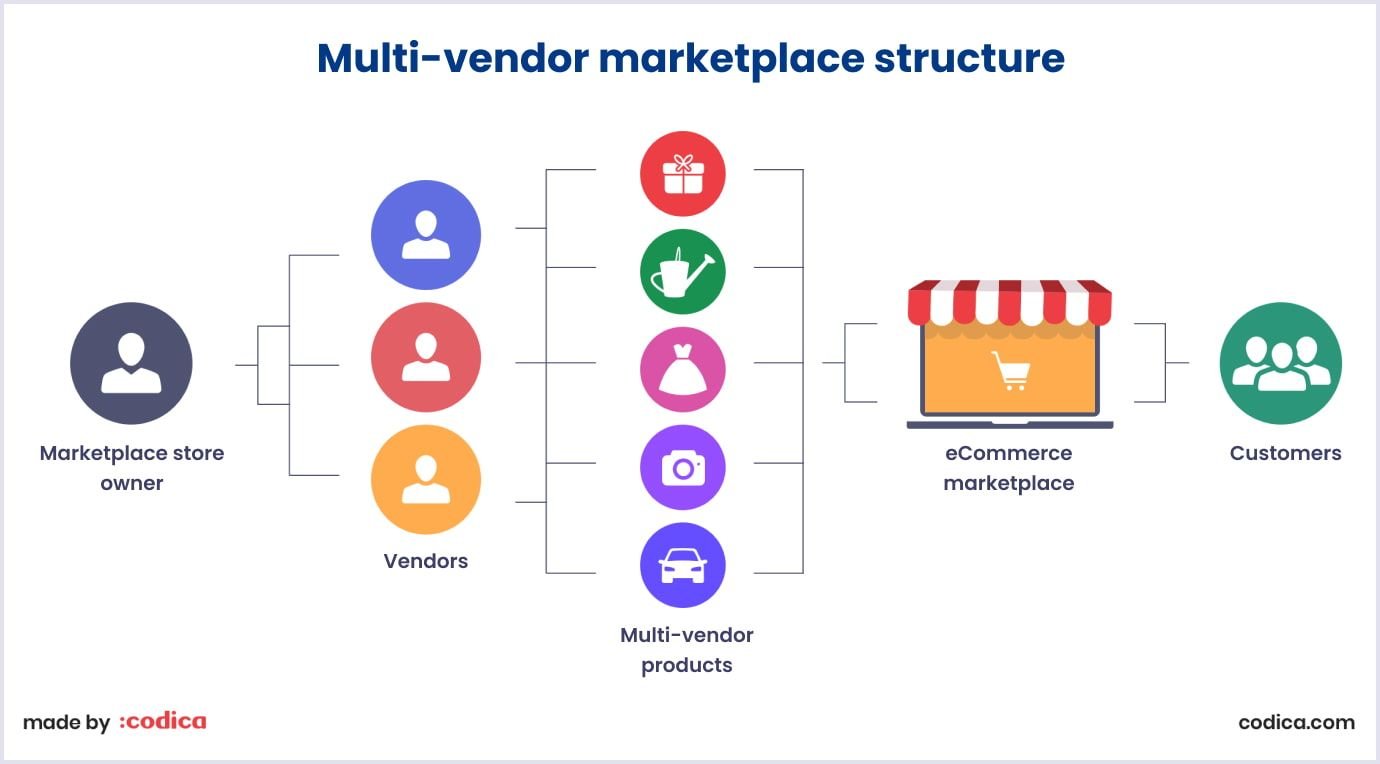
A multi-vendor marketplace allows users to browse the catalog and purchase products from different vendors all in one place. The marketplace owner usually charges a commission on sales made by the vendors and may also charge fees for additional services such as advertising or fulfillment.
One of the differentiating features of this marketplace type is that the platform is managed by a single administrator, most commonly a marketplace owner. As a result, this person provides a single roof for multiple vendors to sell various goods to customers worldwide.
Speaking of examples, there are many key players in the industry. For instance, you can refer to eBay, AliExpress, Amazon, Walmart, or Airbnb.
Successful multi-vendor marketplace platforms can be very profitable. For example, a report from Statista shows that Amazon's revenue is increasing yearly.
Benefits of the multi-vendor marketplace
Marketplaces are very popular with both buyers and vendors. Why? What benefits do users have on the multi-vendor site? In this section, we'll explore some of the key benefits of multi-vendor marketplaces, conveniently dividing them into three categories. We will list the benefits for vendors, buyers, and marketplace entrepreneurs, and provide an overview of why they are helpful.
Advantages for vendors
Allowing vendors to connect with a vast user base has many benefits. Here are several main advantages of developing a multi-vendor marketplace that can attract vendors to your platform
1. Easy and fast online store creation. Vendors do not have to look for contractors to develop a website or launch advertising to attract customers. Everything is ready and pre-configured on the multi-vendor platform. So, creating an online store becomes an easy procedure.
2. Access to a larger audience. The main advantage of creating an online business in the marketplace is direct access to the website's audience. For instance, AliExpress is one of the greatest multi-vendor marketplace examples. Around 200 million users visit it every month.
3. Safe work. There are little to no risks of viruses or hacking issues from outside the marketplace website. All data about stores and products is stored on secure servers. Additionally, data is saved thanks to regular backups. So, even in the event of a hacker attack, vendors will not lose the contents of their stores.
Advantages for buyers
Multi-vendor marketplaces are attractive alternatives to classical ecommerce sites. They offer buyers a unique and convenient shopping experience that is unmatched by other online retailers. Here are the major benefits users get.
1. Sellers rating overview. Buyers are primarily guided by reviews when looking for services or products on the Internet. Therefore, the review is the main tool for attracting customers.
2. Wide selection of products. On marketplaces, a lot of goods from different sellers are collected in one place. So it is easy for customers to compare and choose between them.
3. Permanent discount. Promotions are a really effective tool to increase sales. The multi-seller marketplace obliges vendors to offer discounts on the products presented. Notably, the marketplace strictly monitors prices on the Internet. So, if the price of the products is too high, the vendor will face a serious fine.
Advantages for marketplace entrepreneurs
Multi-vendor marketplaces are a very attractive business extension for entrepreneurs. They provide a built-in network of customers, giving them the ability to grow their businesses. Let’s take a look at the most significant benefits entrepreneurs get when deciding to switch to a multi-vendor marketplace.
1. Fast start and scaling. Today, entrepreneurs can sign up to work with the multi-vendor marketplace in minutes without overwhelming costs. Besides, such marketplaces provide all possibilities to scale the business as they benefit from it as well.
2. Network effect. Built-in network effects occur as more sellers increase selection and price competition, which attracts more buyers to the platform and increases the quality of services provided.
3. Growing revenue potential. Along with the platform's growth, the quality of services you provide also improves. Hence, it becomes reasonable to raise the commission from sellers. The latter, in turn, raises the price of their goods and services. In the aftermath, entrepreneurs grow with the platform, which sets the direction and pace of development.
Multi-vendor marketplace types
Initially, you need to decide what products or services will be provided on the platform. To date, many consumers are still separated from direct communication with product suppliers through many offline shops. This option brings higher costs to the customer as they purchase a turnkey solution and don't know if they could save a great deal of money.
Therefore, if you create a multi-vendor marketplace, your platform can provide customers with lower costs, allowing them to purchase directly from sellers or suppliers. So, narrow your focus and determine the type and category of your services or products, your target audience segments, and your location.
Defining your target audience is extremely important. At the very beginning, it’s more productive to find and attract your unique customers, focusing on their preferences and needs. As the platform scales, you can expand the service and product offerings, thereby covering a wider range of consumer groups.
Depending on the vendor's offerings
Multi-vendor marketplaces can be easily segmented by what vendors offer. Some common types based on the offerings include:

- Product-focused marketplaces. These marketplaces are dedicated to selling physical goods. Vendors sell a range of products, from domestic goods and appliances to electronics and accessories. These are the most common, thanks to giants like Etsy or Amazon.
- Service-oriented marketplaces. These marketplaces are focused on offering various services like home cleaning, web design, consulting, or tutoring. Upwork and Fiverr are good examples of such platforms.
- Rental-focused marketplaces. These marketplaces allow vendors to rent out various items to customers. For example, vendors may rent out equipment for events, vacation rentals, or even clothing. Regarding property rental, Airbnb is an absolute leader.
- Digital product marketplaces. These marketplaces are focused on selling digital products, such as software, e-books, music, and learning content. Udemy is a fitting example of a marketplace that offers various courses.
Depending on the audience type
Major audience preference defines how your marketplace must cater to it. There are three most common audience types.
B2B (business-to-business) marketplaces are created to connect businesses with other businesses. In the B2B marketplace flow, the vendors sell products, usually in bulk, to other businesses rather than individual consumers.
B2C (business-to-consumer) marketplaces connect businesses with individual consumers. The vendors sell products or services that are intended for individuals to use. However, in B2C marketplaces, users can oftentimes purchase goods in bulk.
C2C (consumer-to-consumer) marketplaces are intended to connect individual consumers with other individuals. In C2C marketplaces, vendors earn by selling goods or services directly to different people.
Depending on the marketplace flow
Setting a communication tone for your vendors and customers always impacts the flow of your marketplace. Let’s list five of the most popular marketplace categories depending on the flow. Note that they may also overlap.

- Open marketplace. This type offers the most common model, allowing anyone to sign up as a vendor and start selling their products or services. There is little to no vetting of vendors or their offerings.
- Curated marketplace. Unlike open, curated marketplaces usually have a strict vetting process for vendors and their listings. The marketplace may set limits on certain types of products or services. It may also require vendors to meet certain quality or brand standards.
- Auction marketplace. This type of marketplace allows vendors to auction off their products or services to customers. From the consumer's perspective, they can bid on the products, and the highest bidder wins the item.
- Group-buying marketplace. It provides customers with the possibility to group together and purchase products or services in bulk. The marketplace may also negotiate a lower price with the vendor and then provide products at a discounted rate.
- Subscription marketplace. Such marketplaces allow customers to access the platform via a recurring subscription. Vendors provide products or services on a regular basis, and customers pay a subscription fee to receive them. Alternatively, there are marketplaces that don’t allow vendors to operate without a subscription.
Key features for your online marketplace
The functionality is of utmost importance in multi-vendor ecommerce development. The matter is that the online multi-vendor marketplace platform users (both merchants and buyers) should have the best user experience, which will give your customers the important convenience and simplicity, making them stay and stick with your platform.
Among the most important multi-vendor marketplace features, we recommend that you take into consideration the following list.
Authorization and security
Users must sign up to provide personal details such as name, email, phone number, and password. Also, the registration process should be as easy and as fast as possible. Users need to fill in only the most important data. Other information should be specified later.
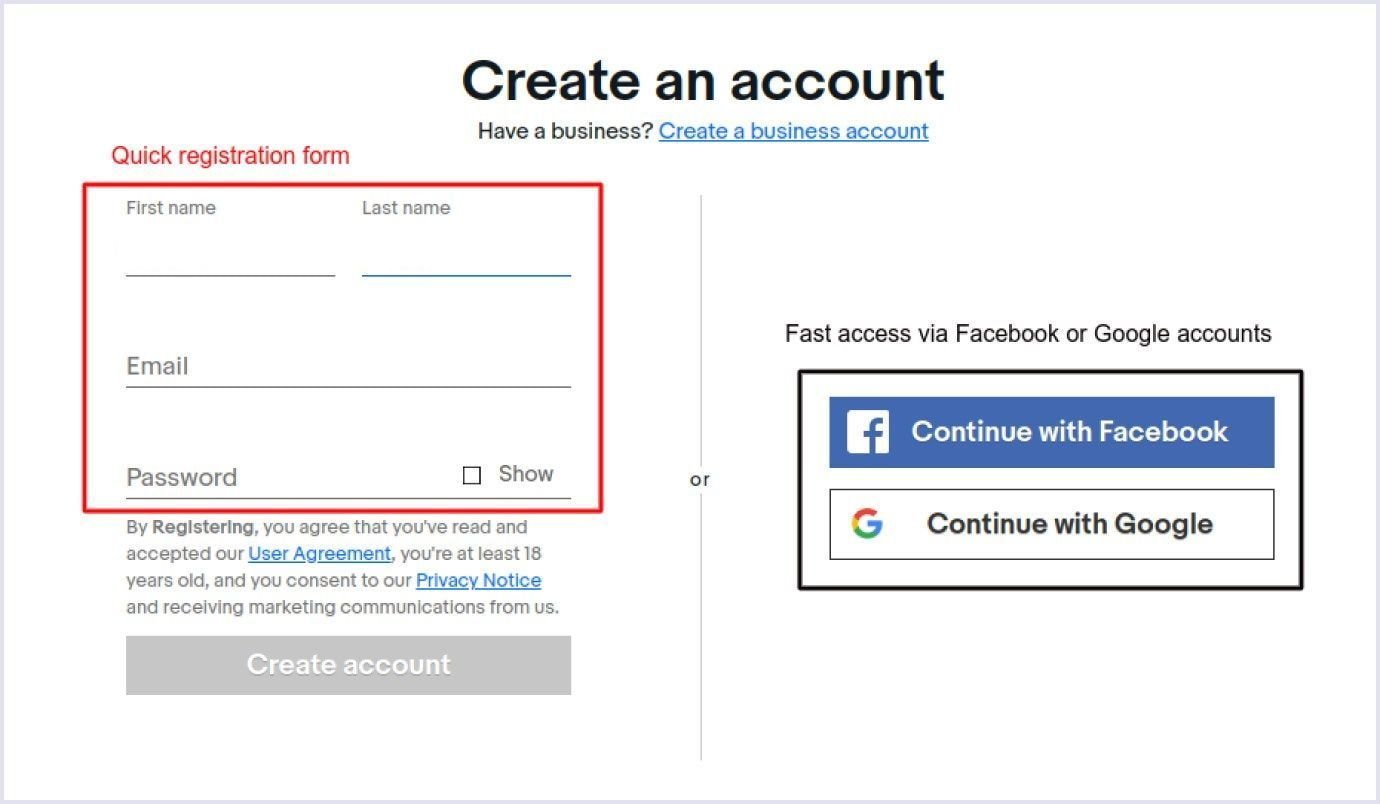
Registration for both vendors and buyers
A multi-vendor marketplace platform should provide an opportunity to create a personal account. For sellers, it is the primary option to create their online stores and start trading. For buyers, it is a boost in user experience, as they can personally chat with the vendors, add stores and items to favorites, etc. Also, it is important for users to have the same account for selling and buying goods and services.
Managing user profile and personal details update
This feature is more crucial for vendors than consumers in a multi-vendor marketplace solution. The reason is that store information should be comprehensively presented and easily managed by its owner.
Managing items listing
Sellers need to publish and manage their items’ listings. This feature allows them to update item information, such as specifications, description, price, etc.
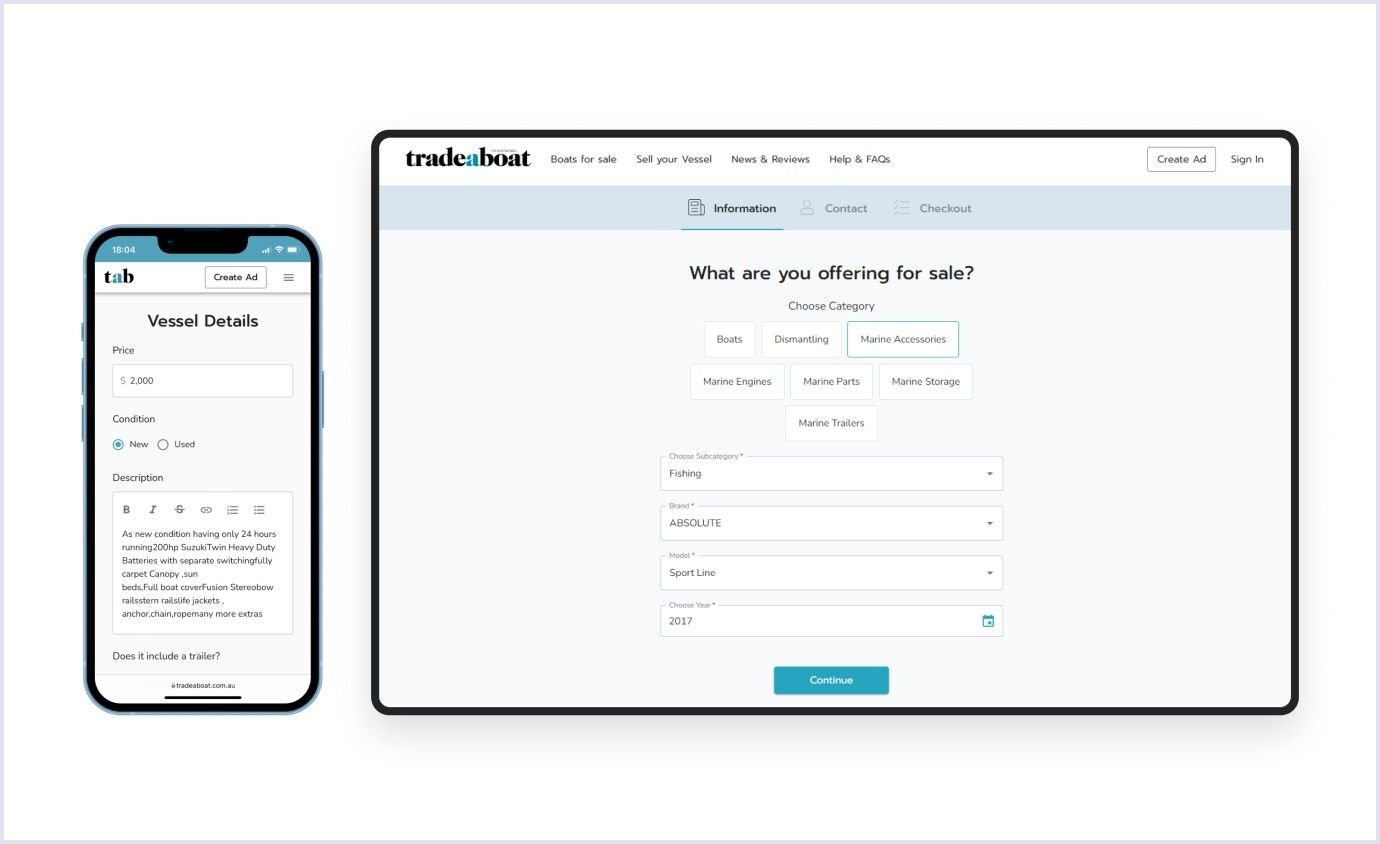
Source: Tradeaboat case study
Search & filters
You need to provide buyers with an easy-to-use and efficient search option when you create a multi-vendor website. This way, a platform user has an opportunity to find the required product/service easily and rapidly.
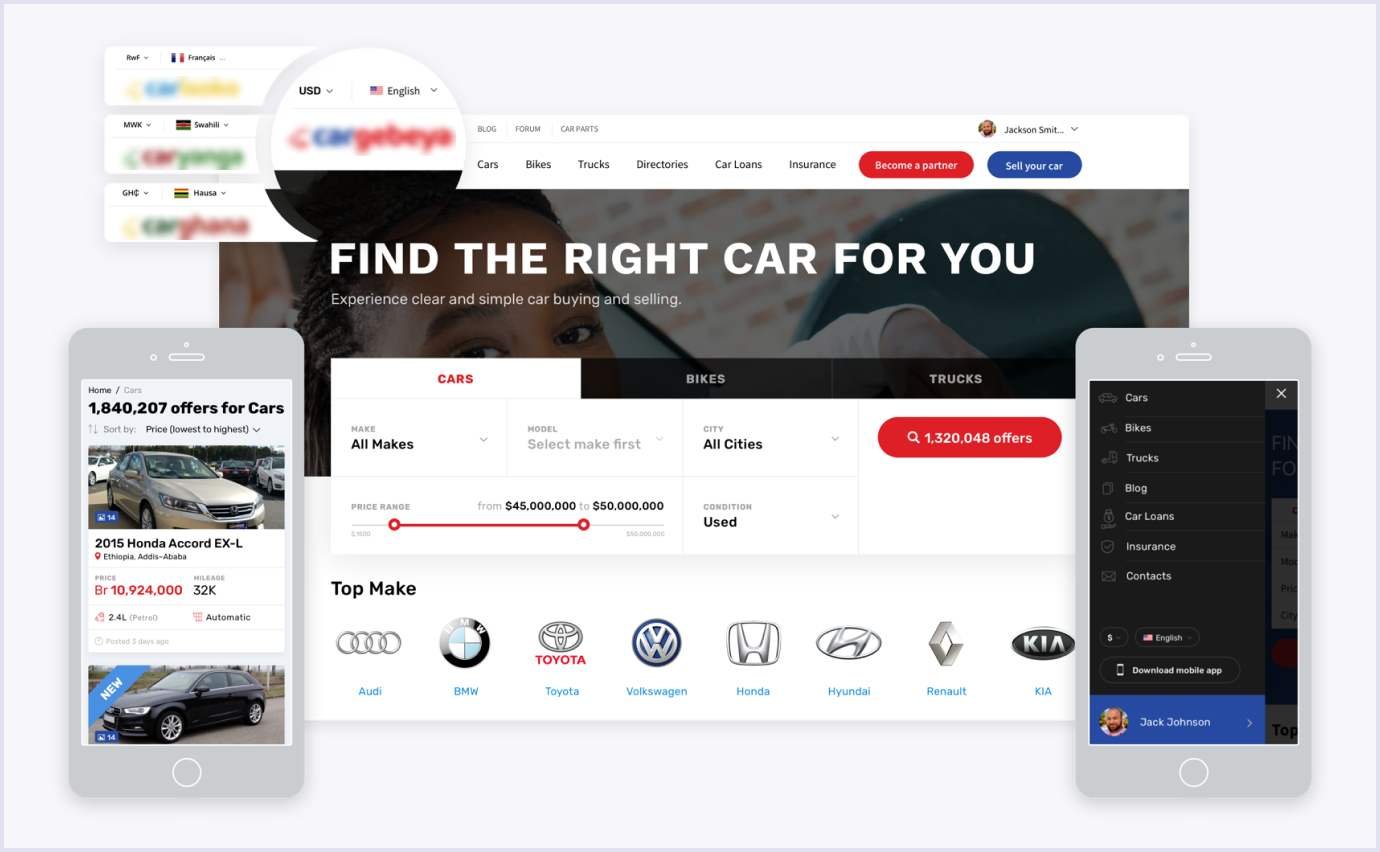
Source: Automotive marketplace case study
Statistics
This option allows sellers to track their activities. Leads, views, sold, not sold, etc.
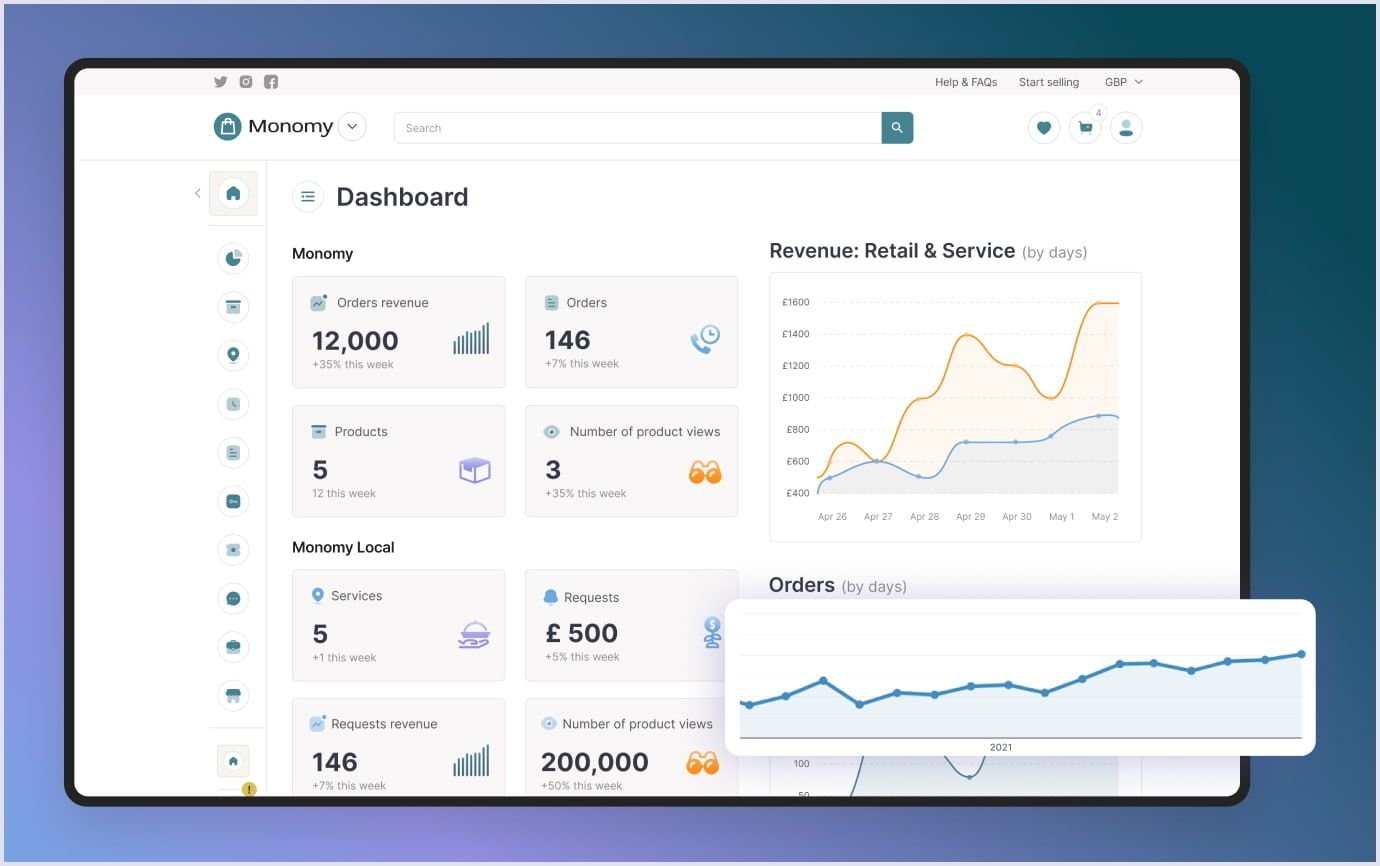
Source: Ecommerce marketplace case study
Boost options
This feature provides the marketplace owner with monetization opportunities. Alongside the platform, sellers gain a chance to promote their product/services.
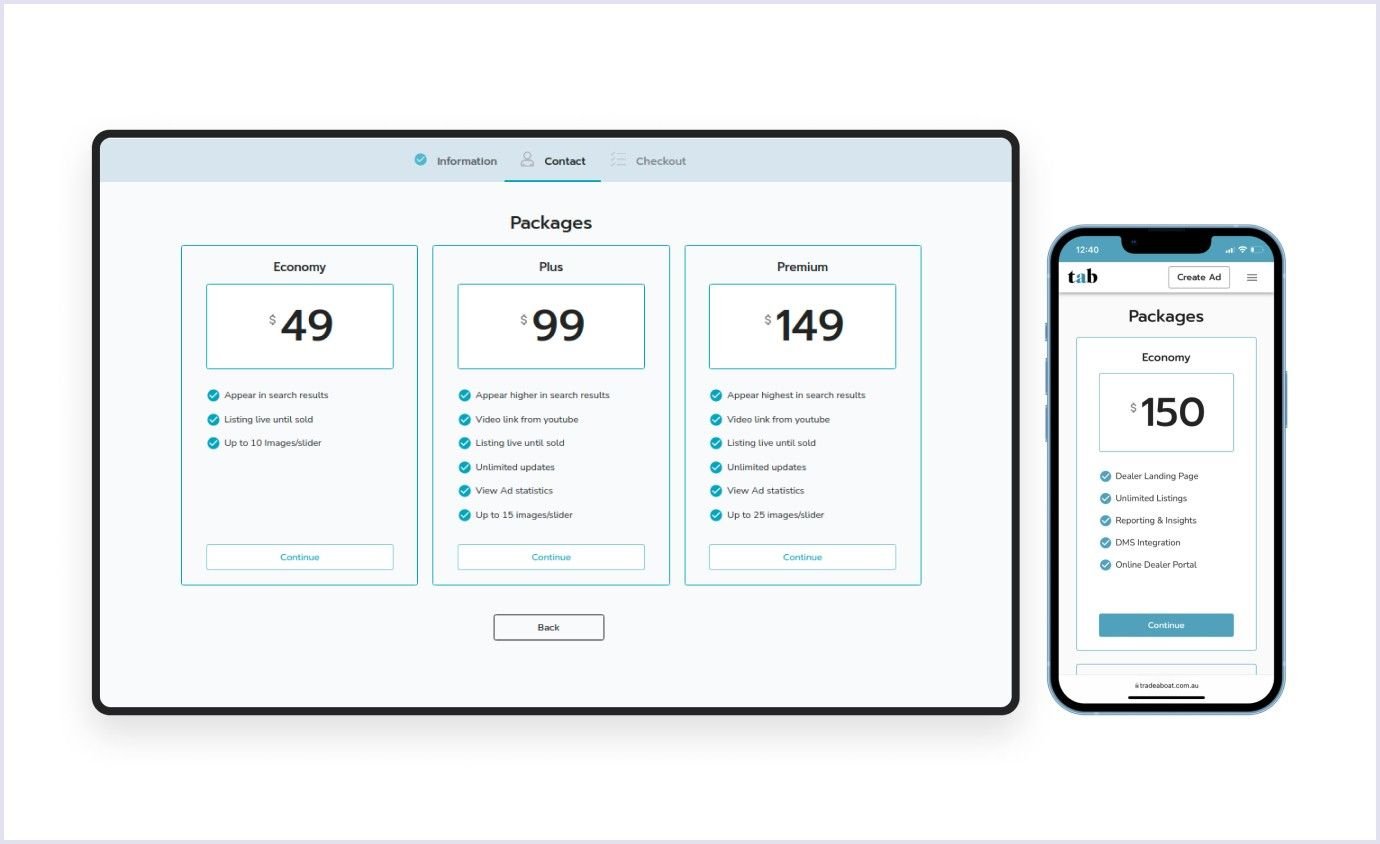
Source: Tradeaboat case study
Ratings and reviews
This option allows the buyers to increase the credit of trust with the platform and its sellers. Thus, the marketplace sellers are interested in providing excellent service and keeping their store ratings high.
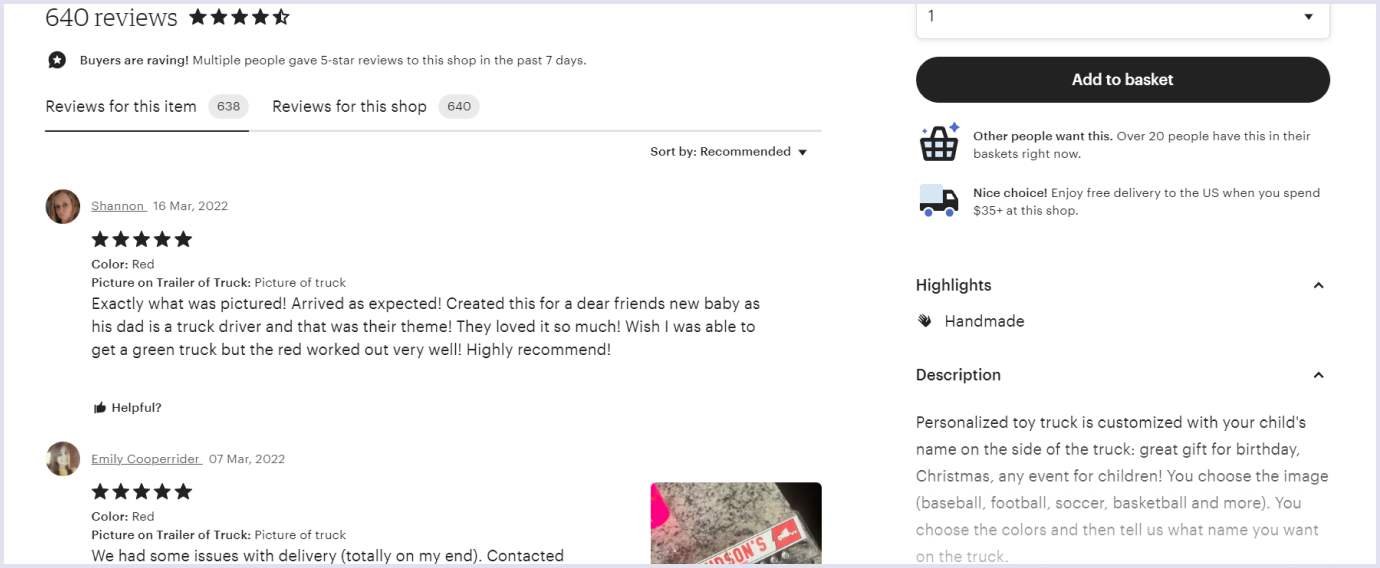
Source: Etsy
Payment functionality
Every multi-vendor marketplace website requires advanced payment functionality: the ability to use credit cards, payment services (PayPal, Stripe), billing, and invoice operations.
These are the primary features your marketplace should have. Once they are integrated, you can expand the platform functionality with the following:
- Notifications;
- Landing pages for clients and vendors;
- Browsing content;
- Customer service;
- Shipping options;
- Localization;
- “Request a quote” option (if the marketplace is service-oriented);
- Substitute/complementary goods;
- An option to compare products/services.

Tech stack for a multi-vendor marketplace platform
An online marketplace must be built with robust technologies to function properly and withstand peak loads during sales or other periods of high traffic. That’s why we recommend using specific technologies for the frontend, backend, infrastructure, and DevOps to ensure your platform is stable and reliable.
Thus, at Codica, we use a time-proven tech stack, including:
- Frontend: JavaScript, React, Vue.js for the client side, where users interact with your website;
- Backend: Ruby, Ruby on Rails, Node.js for the server side, where processes are aligned and ensured;
- Infrastructure: AWS to provide a robust environment for your solution;
- DevOps: GitLab CI, Docker to streamline development processes, testing, and continuous monitoring.
Below is a comprehensive image of the tech stack selection we have found to be future-proof and reliable, based on our years of experience.
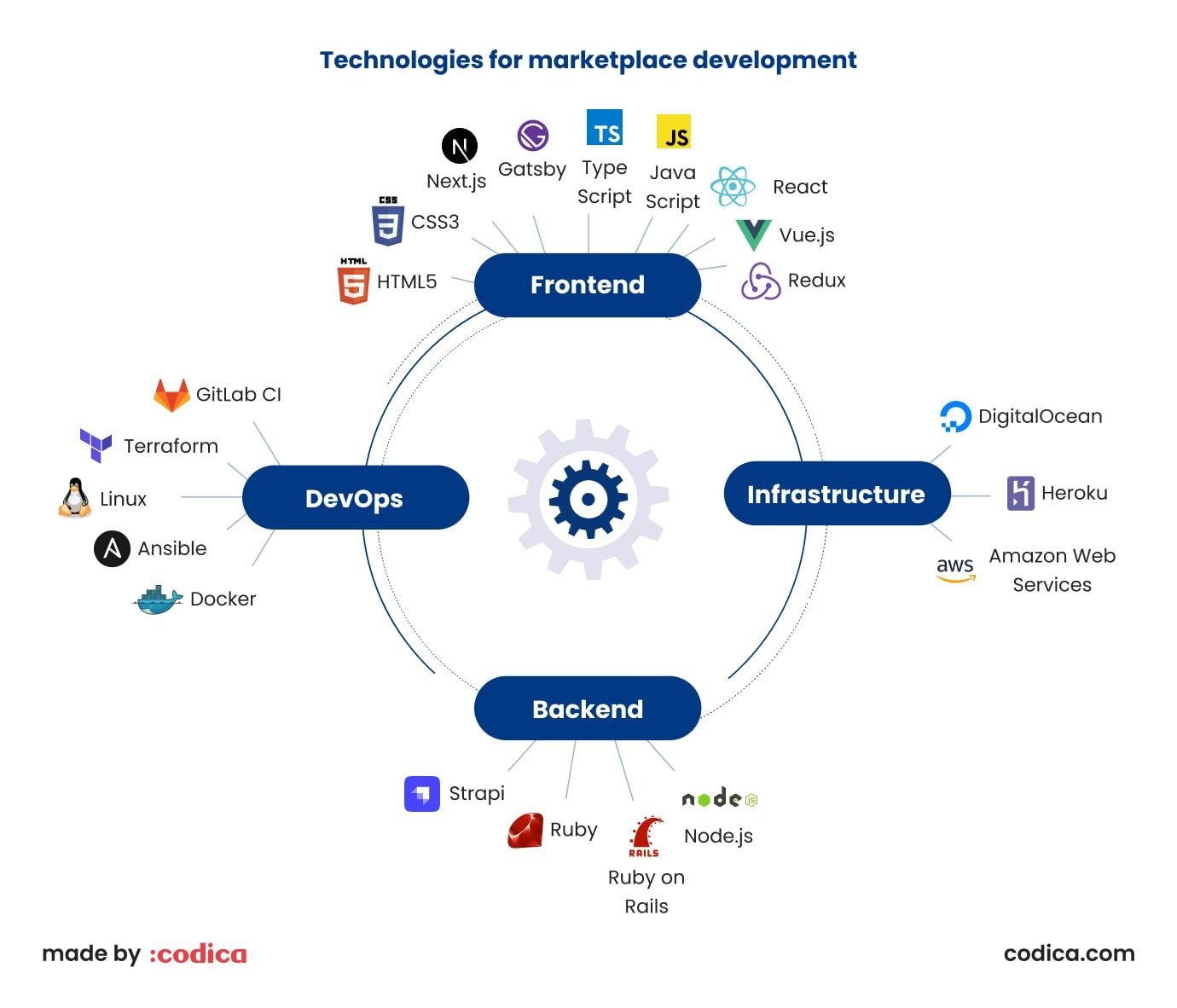
Steps to create a multi-vendor marketplace website
Creating a multi-vendor marketplace website involves several crucial steps. They will guide you in building a successful platform that attracts vendors and customers, ensuring your marketplace thrives in the competitive ecommerce landscape.
Step 1: Hold product discovery and research
What is product discovery, and why should you opt for it? It’s an essential step to understand if your idea is feasible. Thus, you start building your multi-vendor site with a clear vision, just like a house starts with a neat and descriptive layout. Here are several aspects that contribute to the clarity:
- Deep market research;
- Understanding your target audience;
- Discovering your marketplace’s unique value proposition;
- Outlining the essential features that will make your product marketable;
- Defining the solution’s architecture and tech stack;
- Estimating the timeline and cost needed for the project;
- Determining team composition for your platform.
With those assets, you minimize risks, optimize development, save costs, and make informed decisions. Check out the video below that discusses what you get after product discovery at Codica.
Our team provides you with the relevant deliverables upon the project discovery phase, so you can decide whether to proceed with your project based on specific data.
Step 2: Take care of the design
As UI/UX design services start at the project discovery phase, they bring clickable prototypes first. These are simulations of the future solution, so you can view them and understand how your multi-vendor marketplace will work. Clickable prototypes are handy as they help you visualize your solution with the minimum investment.

When the prototypes are agreed upon, the design team proceeds to add styles to your product. Thus, your brand style is preserved and recognizable to your customers.
Here are several tips from our design team on how to make your multi-vendor website appealing through UX and UI.
Make navigation easy
Navigation and user journey are the cornerstones of usability when you create a multi-vendor website. The easier it is to buy products, the more sales are generated. You need to make the whole marketplace navigation options clearly visible without creating a deep nesting. Build an easy-to-understand and efficient user flow that will allow them to find and purchase the desired products in a few steps.
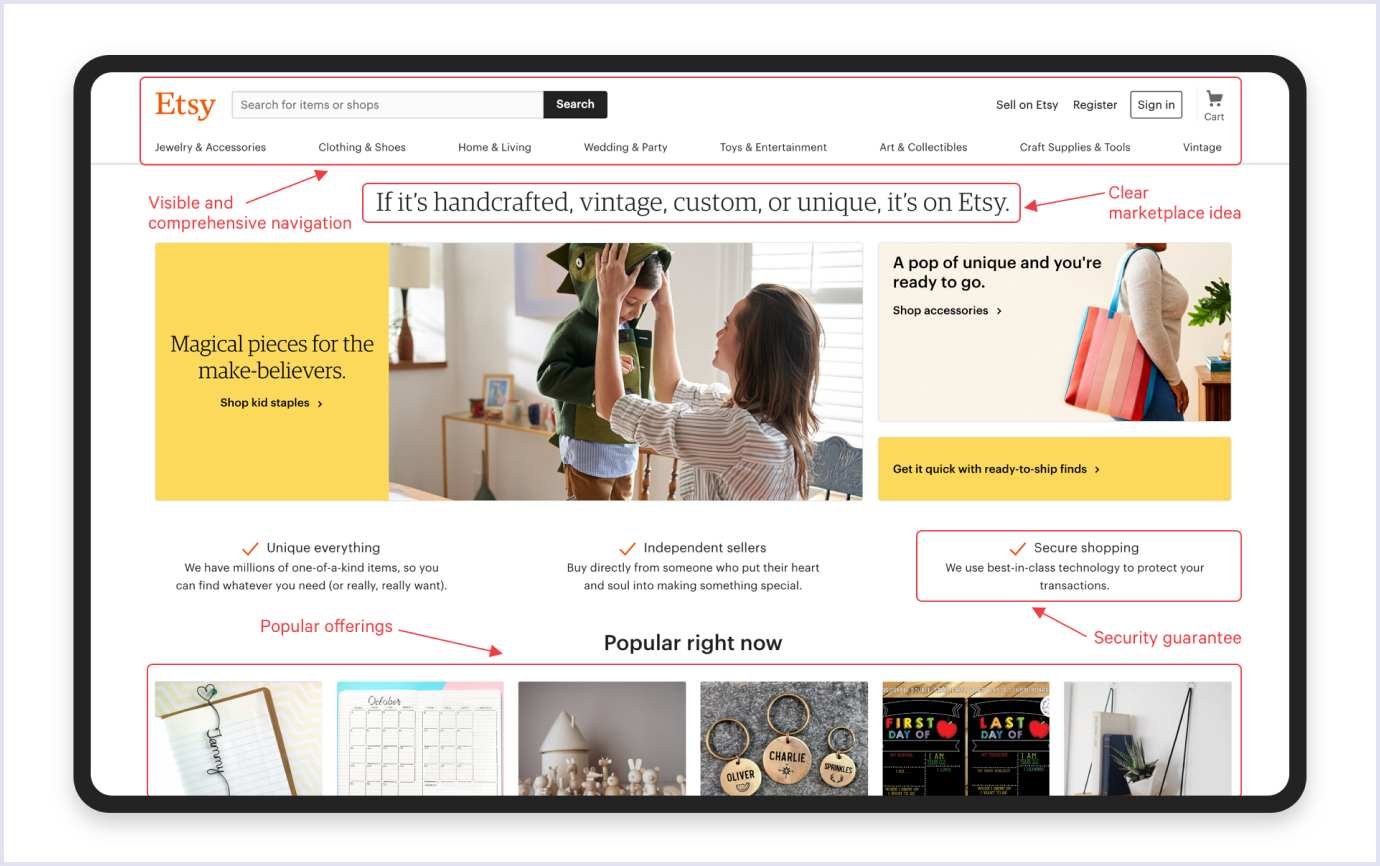
Source: Etsy
Establish credibility
Try not to overload pages with tons of information not to make the users overwhelmed. You can create trustworthy photos of products, provide full product descriptions, and a system of ratings and reviews. Also, you need to establish a secure purchase and refund policy to make the user confident while working with your marketplace.
Increase user engagement
Make your multi-vendor marketplace idea clear. Primarily, provide the users with a complete understanding of the products and services available on the platform. Also, highlight the main features that make your multi-vendor marketplace better than competitors. Users don’t like solving puzzles. Your platform idea and benefits should be clear for any user within the very first seconds.
Related reading: Online Marketplace Design: Why UI/UX Matters
Step 3: Create and launch a marketplace MVP
Once you have defined the must-have features for your platform, we recommend building a minimum viable product (MVP) instead of creating a fully functional product right away. This concept is rather effective and not so time- and cost-consuming as the full multi-vendor marketplace development.
During MVP development, we recommend implementing the platform's functionality from the product discovery step, which includes must-have features that the platform cannot function without.
Then, implement those must-have features on your multi-vendor marketplace. When you gain positive feedback from the community and investors, it becomes reasonable to expand your multi-vendor marketplace functionality with additional options.
With the help of the MVP approach, you will get the following advantages at this multi-vendor marketplace development stage:
- Fast release. You have an opportunity to roll the product to the market within the shortest possible time.
- Saving time and money. You develop only the required features, spending much less money.
- Knowing the customers’ needs as soon as possible. You collect the community’s feedback to improve your product.
- Finding the early adopters. A marketplace MVP allows the creation of a potential client base that may provide you with the so-called trendsetters.
- Additional improvements. When receiving feedback on the customers' needs and preferences, you need to bring new ideas and exclusive offerings to make your product more attractive. That means more chances to drum up your business.
Further reading: Building a Future-Ready Marketplace with MACH Architecture
To conclude, there is actually no reason to spend more time and money at this development stage. Here, you need to understand whether your product is valuable, offers preferred features and solutions, or is better than existing competitors. Launching a marketplace MVP first allows you to collect your customers’ feedback, process their comments, improve your product, and head toward the major release.
Considering the ways of creating an MVP, we want to emphasize the most relevant and effective options:
Choose ready-made solutions
Around the web, you can find dozens of turn-key platform solutions that consider your ideas, preferences, and requirements to launch the marketplace as fast as possible.
Build your marketplace from scratch
When you come to from-scratch software development, you must use the most trending technologies. The matter is that they provide you with up-to-date and extended features and tools with huge community support. Among the most popular technologies, we recommend Vue.js and React for frontend development. To manage the backend part, we prefer to use Ruby and Node.js.
Considering the software development providers, we recommend hiring a reliable and solid software development company. The main benefit of this choice is that such agencies have profound experience in providing MVP development services that allow you to be sure of getting exactly what you need.
Step 4: Perform testing and quality assurance
When development is complete, it’s time to ensure that your marketplace functions properly with its components and as a whole. Specific requirements must be met so that customers enjoy your marketplace and return for repeat purchases.
To ensure the marketplace’s proper work, our quality assurance services include performance testing, security testing, and API testing. Rigorous functionality, responsiveness, and accessibility testing are necessary to ensure that your marketplace functions properly across different screen sizes, for various users, and performs as intended.
Security is a top priority. Ensure that your solution supports GDPR and CCPA compliance, utilizes TLS protocols for secure data transmission, and employs two-factor authentication.
We recommend you perform manual and automated testing before launching your marketplace. Well-thought-out quality assurance services provide you with the solution that will delight your customers and build trust in your multi-vendor platform.
Step 5: Maintenance and support
As your marketplace lives and evolves, it needs regular monitoring and support. For example, our DevOps services include continuous monitoring for vulnerabilities and necessary patches. Whenever you need an update for a feature or want to add a new one, our team is eager to help with design, development, and testing. That’s how your multi-vendor marketplace stands out in competition and attracts more customers.
Things to consider for the growth of your multi-vendor website
Choose a monetization strategy
A monetization strategy refers to how you earn money on the platform. Thus, you need to define a revenue model to generate a preferable profit and not scare your potential vendors with the conditions.
Below is the list of the most commonly used monetization strategies.
Subscription fee
For instance: vendors pay $15 per month for a subscription.
Transaction fee
For instance: vendors pay 4% of the transaction value.
Listing fee
For instance: vendors pay $10 for listing each product on your marketplace.
Premium listings
For instance: vendors pay $5 for a premium listing, which stays higher in the feed for a week.
Advertising
Featured ads are an excellent way for vendors to promote their products and get more visibility within your multi-vendor marketplace platform.
Finally, the best way to prove the capability of these strategies is to see what well-known brands implement them. Let’s take a look at some benchmark companies.
| Monetization strategies by famous companies | |
| Subscription fee | eBay, Amazon, WIX, Docplanner |
| Transaction fee | Shopify, Etsy, eBay, Amazon, Stripe |
| Listing fee | Etsy, eBay, Mercado Libre, OLX |
| Premium listings | OLX, Craigslist |
| Advertising | Amazon, eBay, Facebook, LinkedIn, X, Snapchat |
Acquire vendors and buyers
Now, let’s discuss the sellers’ acquisition and the tactics you can implement and use to get the supply and demand and solve the “chicken & egg” problem, sometimes even before launching your marketplace platform.
Attract vendors
- Build your first supply. In the early days, one of the smartest things may be producing your own inventory on the platform. It provides you with a good start, attracting first buyers and, subsequently, sellers.
- Get your supply from someone else. There are tons of products and services available on other existing marketplaces. You can list them on your platform to generate the initial user acquisition.
- Provide monetary subsidies. You can encourage this platform side via monetary subsidies. Such well-known giants as Facebook or Uber, in their very beginning, were ready to pay cash to attract users to the platforms.
Attract buyers
- Have your supply bring your demand. Your platform will definitely have sellers that are known worldwide. So, you can stimulate them by providing different premium features, and then you will promote your marketplace back.
- Motivate potential customers. Similarly to providing monetary subsidies to your vendors, you can offer buyers a certain amount of money for signing up early. Surely, you should not just give away cash for people’s emails. For example, you can provide a discount on the first order or offer $5 off the first purchase.
Attract both parties
- Leverage channel partners. Over time, you may need to enter into partnerships with marketplaces in complementary niches. It will provide both of you with beneficial results in the number of new platform users.
- Target buyers and vendors within the same community. In case consumers and sellers share common interests in similar goods and services, then they can become interested in such trading on your platform.
Promote and grow
Multi-vendor marketplace promotion is a tough hill to climb. For this reason, here we want to provide you with several efficient techniques to grow your online marketplace platform. Surely, each of them requires a separate article to be discussed, but we want to point out the primary moments.
Socials
Many consider social media networks as a tool for personal communication. However, this is not exactly correct. Socials, such as Instagram, X, Facebook, YouTube, Medium, and others, are not only about community conversation. Actually, you can effectively benefit from using these channels to promote your brand’s online activity and appreciation.
SEO optimization
Search engine optimization is crucial for your multi-vendor marketplace. You need to be at the top of Google, Yahoo, Bing results when potential buyers are looking for the products available on your platform.
Email marketing
Once you have launched your multi-vendor marketplace platform, start collecting the email addresses of your clients. You need to build email lists to retain existing customers, which is even more important than attracting new ones. The reason is the following: if they bought a certain item from you once, they are more likely to do it again, as there is a high level of trust.
Paid ads
The paid-for advertisement is quite a powerful tool for promoting your multi-vendor marketplace. For example, such an option as Google Ads increases your opportunities to acquire more users from search engines.
Best software solutions to build a multi-vendor marketplace
Building a multi-vendor marketplace can be a challenging task, but choosing the right software or solution can make the process much easier. With so many options available, finding the best fit for your marketplace can be overwhelming. Next on, we’ll consider several options with their respective ups and downs to make the selection process less daunting.
Multi-vendor open-source solutions or scripts
Typically, these are software applications that allow you to create a multi-vendor marketplace using open-source code. They are often free or cost less than proprietary software. You can often find numerous of them on platforms like GitHub. Also, there are platforms that either provide tools required to build your platform or plugins to expand it.
| Pros | Cons |
| Can be a low-cost alternative to proprietary solutions | Requires technical expertise and development time to customize and set up the software |
| High level of control over the marketplace, as the source code is available for modification and customization | May not be as feature-rich or customizable as proprietary solutions |
| Large communities of developers and users who can provide support, guidance, and feedback on the software | May have limited or no support options, depending on the software and the community behind it |
| Access to a range of features and functionality, including product management, order management, payment processing, and shipping | Security concerns as open-source software can be more vulnerable to hacks or exploits due to its open nature |
Multi-vendor marketplace on WordPress theme or plugin
An alternative to creating a multi-vendor marketplace is utilizing WordPress themes and plugins, with WooCommerce and Dokan Multi-Vendor being the most well-known plugins.
This approach allows you to launch your marketplace with a lower initial investment, particularly if you have limited technical skills. However, to achieve the necessary functionality and process payments legally, you may need to use multiple plugins. This also means that maintaining your site will require regular upkeep.
| Pros | Cons |
| Low upfront investment | Limited number of features |
| Easy setup and usage processes | Requires additional plugins and add-ons |
| Large and helpful community and support | May have security concerns |
Ecommerce builder + extensions
Another viable way of multi-vendor ecommerce development is by utilizing ecommerce building services and expanding them with extensions. Some of the popular ecommerce builders and extensions for this purpose include Shopify, Adobe Commerce (Magento), and OpenCart.
It is considered a pretty decent option to build a marketplace, but there will always be certain limitations depending on the platform specifics. Let’s take a swift look at this approach’s respective pros and cons.
| Pros | Cons |
| Easy to use | Some builders/extensions may require payment for additional features |
| Large community and advanced support level | Limited customization |
| Built-in features for payment, inventory, and shipping management | Requires technical skills to setup and maintain the product |
Challenges of building a successful multi-seller marketplace
Starting a multi-vendor ecommerce platform is a great, but not very simple task. Let's see what are the main difficulties the creator of the marketplace can face. Forewarned is forearmed.
The chicken and egg problem
The chicken and egg problem is the situation when the founder tears between attracting both buyers and vendors.
Vendors are vital because, without them, users can not buy anything. On the other side, buyers are also important for the success of the multi-vendor marketplace platform. So, the focus should be to get vendors and buyers concurrently for maximum success.
Etsy is one of the multi-vendor marketplace examples that successfully solved this problem. The Etsy representatives visited various art exhibitions. There, they "recruited" the most reputable artists and collectors. Their followers went after them. In such a way, the "recruited" sellers led their client base to the Etsy site.
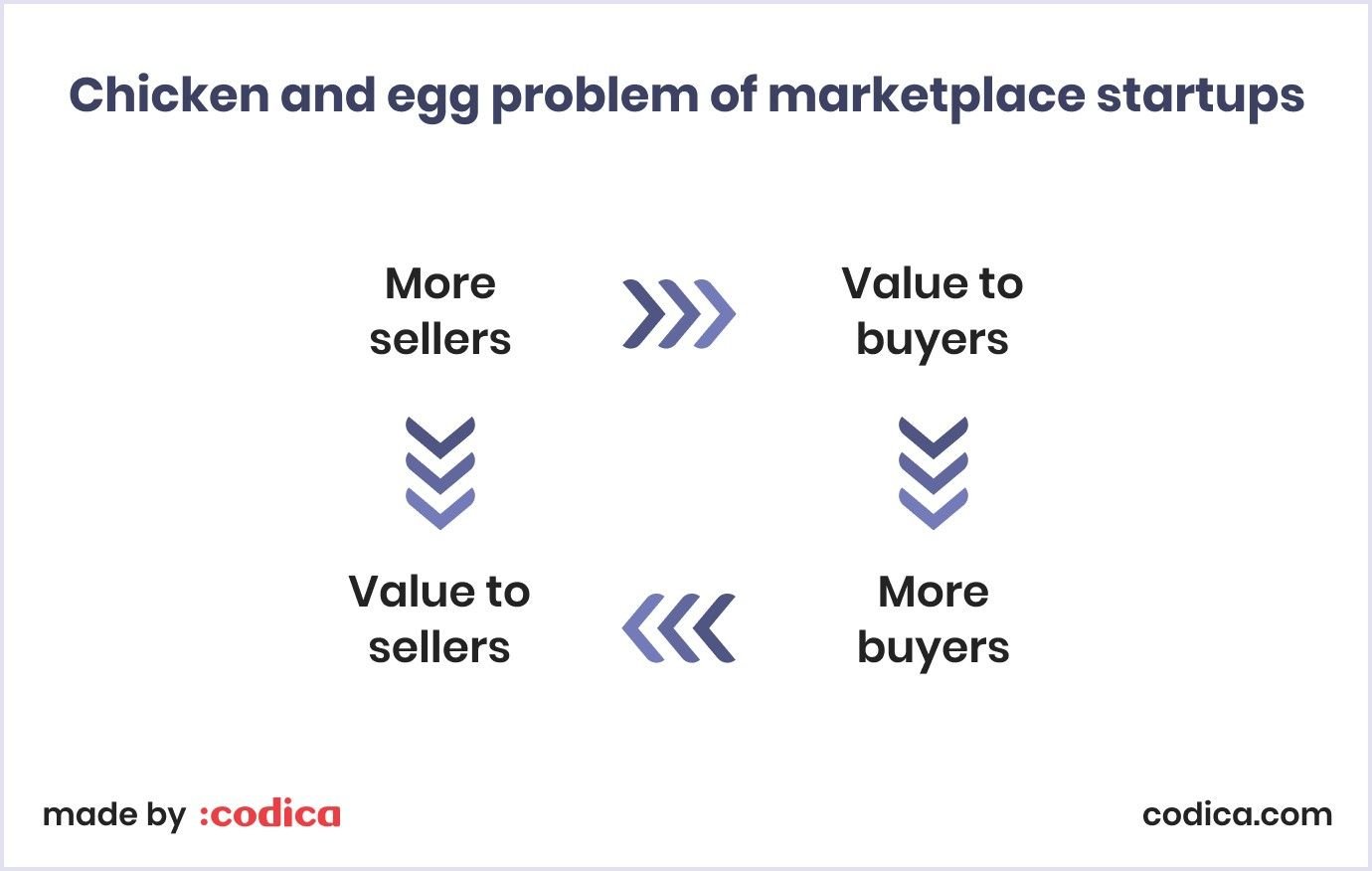
Lack of proper promotion
Another major challenge of an online marketplace is the limited promotion of the multi-vendor ecommerce platform.
Of course, starting with SEO is vital. By providing quality content and using the right keywords, SEO can assist the marketplace in becoming visible in the online space. Marketing on social media and partnering with other brands are also essential aspects. They bring a good identity to the marketplace.
Low retention rate
One more marketplace issue that arises is a low retention rate. Sometimes, when marketplaces focus on attracting new users, they fail to keep their existing client base.
It is good to start with a subscription-based model for vendors. Subscriptions can enhance profit. Also, they ensure that the users won't leave the platform before their subscription period ends.
To enhance the retention rate for any marketplace, personalize the customer experience. Enterprises should conduct user surveys and identify the needs of both vendors and buyers. Then, companies can focus on improving user satisfaction, utilizing tools and strategies with enterprise custom software development services.
Selecting the web development approach
When it comes to developing a multi-vendor ecommerce platform, you can select from two options:
- Ready-made solution
- Custom software
If you aim to create a marketplace platform fast, you can pick a ready-made solution. For example, Adobe Commerce (Magento) provides such services for development.
However, an off-the-shelf solution has disadvantages. For instance, the impossibility of making some customizations. Also, your competitors can use the same template.
Of course, custom software development services require more resources. However, it is a perfect option for marketplace development. This way, you decide the functionality the marketplace will contain.
The main variants are as follows:
- Freelance services;
- In-house development team;
- Software development firm.
By choosing the last variant, you can be sure to get the solution you aim for. Nevertheless, it is imperative to select a reliable and experienced development team.
A self-owned marketplace for businesses is a very promising project. However, the development will require considerable time, effort, and financial resources. On the other hand, if you are seriously planning to implement it, nothing is impossible.
To facilitate multi-vendor marketplace development, you can always turn to specialists. They optimize costs, meet deadlines, and develop a marketplace the way you imagine it.
Multi-vendor marketplace development cost
A multi-vendor marketplace is a complex structure. Usually, it has different functionality, navigation, and architecture. These factors make cost prediction quite difficult. However, at Codica, we build numerous marketplaces and have a good grip on estimating their approximate cost. For example, according to the table below, a solid multi-vendor marketplace MVP costs $58,200 at an hourly rate of $50.
| How much does it cost to build a multi-vendor marketplace? | ||
| Features | Time, hours | Cost ($50/h) |
| Design | ||
| UX development | 56 | $2,800 |
| UI development | 80 | $4,000 |
| Architecture | ||
| Project setup | 24 | $1,200 |
| DB structure | 32 | $1,600 |
| Integrations | ||
| Payment (Stripe or PayPal) | 64 | $3,200 |
| Shipment (Shippo) | 32 | $1,600 |
| Main functionality | ||
| Authorization and security | 24 | $1,200 |
| User profile | 42 | $2,100 |
| Homepage | 24 | $1,200 |
| Search and filters | 48 | $2,400 |
| Product page | 56 | $2,800 |
| Reviews and ratings | 40 | $2,000 |
| Shopping cart | 40 | $2,000 |
| Payouts | 42 | $2,100 |
| Notifications | 32 | $1,600 |
| Buyer panel | 120 | $6,000 |
| Vendor panel | 128 | $6,400 |
| Admin panel | 96 | $4,800 |
| Non-development activity | ||
| Project management | 64 | $3,200 |
| Quality assurance | 80 | $4,000 |
| Code review | 40 | $2,000 |
| Total | 1164 | $58,200 |
Located in Eastern Europe, we can boast significantly lower prices compared to the EU and US markets. Another worth-noting point is about complexity. As mentioned earlier, the functionality may differ. Accordingly, the cost will vary as well, depending on what you are aiming to implement.
Read also: How Much Does It Cost to Build a Marketplace Website in 2026
How Codica can help you with online marketplace development
At Codica, we provide online marketplace development based on our expertise in modern technologies, security, and accessibility. It is crucial for us not only to create a tool but also to ensure it brings tangible results to our clients.
For example, we helped our Australian customer create a boat marketplace.
Our client wanted to improve online business results by attracting more website leads. Codica’s team was tasked with creating a mobile and user-friendly marketplace website that was visually appealing.
Thanks to Codica’s team of experts, our customer received a clean, effective, and optimized multi-vendor platform. Also, due to third-party integrations we maintained, the Trade A Boat marketplace increased the number of listings. As a result of our work, the performance of the website has improved significantly, with lead generation growth of 480%.
Multi-vendor marketplace examples from Codica
At Codica, we build marketplaces in different domains. They vary in functionality, business model, and employ various technologies. In this section, we’ll cover some examples of marketplaces we built throughout the years.
PlanMyKids – an activity booking marketplace
PlanMyKids is a service marketplace that allows parents to book, plan, and schedule activities for children.
It features a thoughtful kids-oriented UI/UX design, convenient itinerary management functionality, and an advanced calendar for parents. After all, this platform is the ultimate helper for parents, boasting its performance, comfort, and ease of use.
iExpedition – an online travel marketplace
iExpedition is a travel marketplace platform built in a very narrow niche and is centered around polar expeditions. Our cooperation has lasted for several years already, and as of now, we maintain the platform, adapting it to today’s needs.

Today, iExpedition features a secure booking system, conveniently built ship listings, an advanced search system, and even educational content to expand travelers’ horizons.
Multi-vendor ecommerce marketplace
Here is another attention-worthy marketplace we recently built. It is a cohesive and convenient multi-vendor marketplace platform that combines B2C and C2C business models.
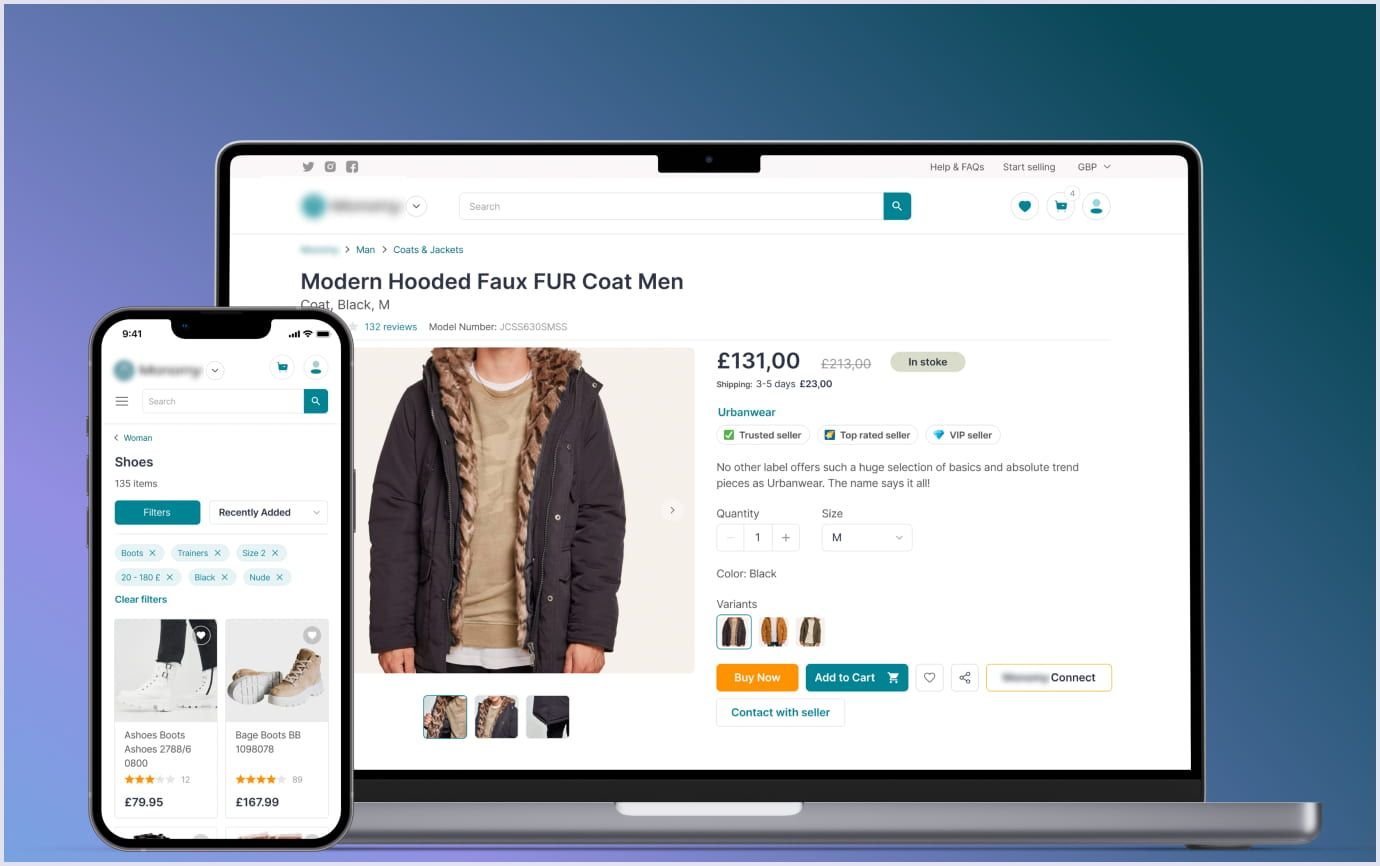
As a result, this multi-vendor marketplace has many neat features. They include functionality to switch between B2C and C2C parts of the marketplace. We made sure to provide a convenient search system, an advanced administration panel, and secure payment integrations.
Conclusion
Multi-vendor marketplace development is a complex, time- and cost-consuming process. You need to take into account all those aspects we have discussed to be competitive, advantageous, and achievement-oriented.
Building a successful multi-vendor marketplace is as much about thoughtful planning and structure as it is about coding and design. Under the hood, the right technology stack and infrastructure ensure the marketplace performs well, even under heavy loads.
Trust-building and marketplace governance features are also essential. They support a healthy ecosystem. There, buyers can be safe, sellers can be supported, and the platform owner can manage growth responsibly.
Are you looking for a multi-vendor marketplace development company that can quickly and efficiently build a website? The Codica team has created many multi-vendor marketplaces, and we will gladly help to create yours. Check our portfolio and contact us to discuss your project.
